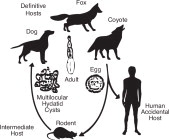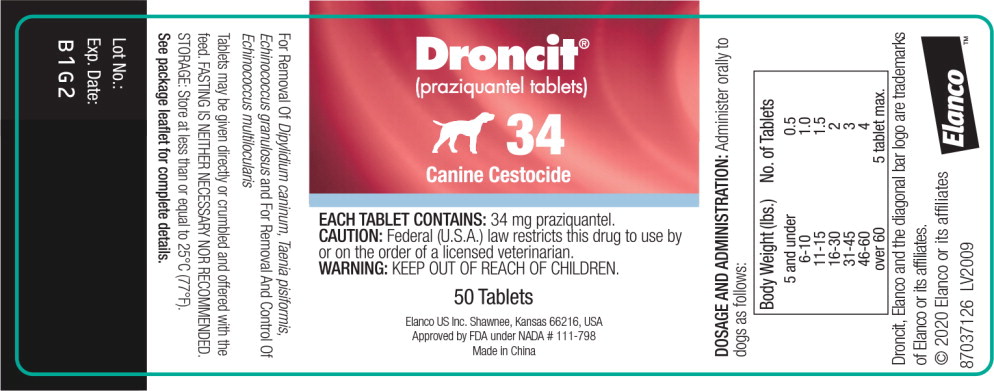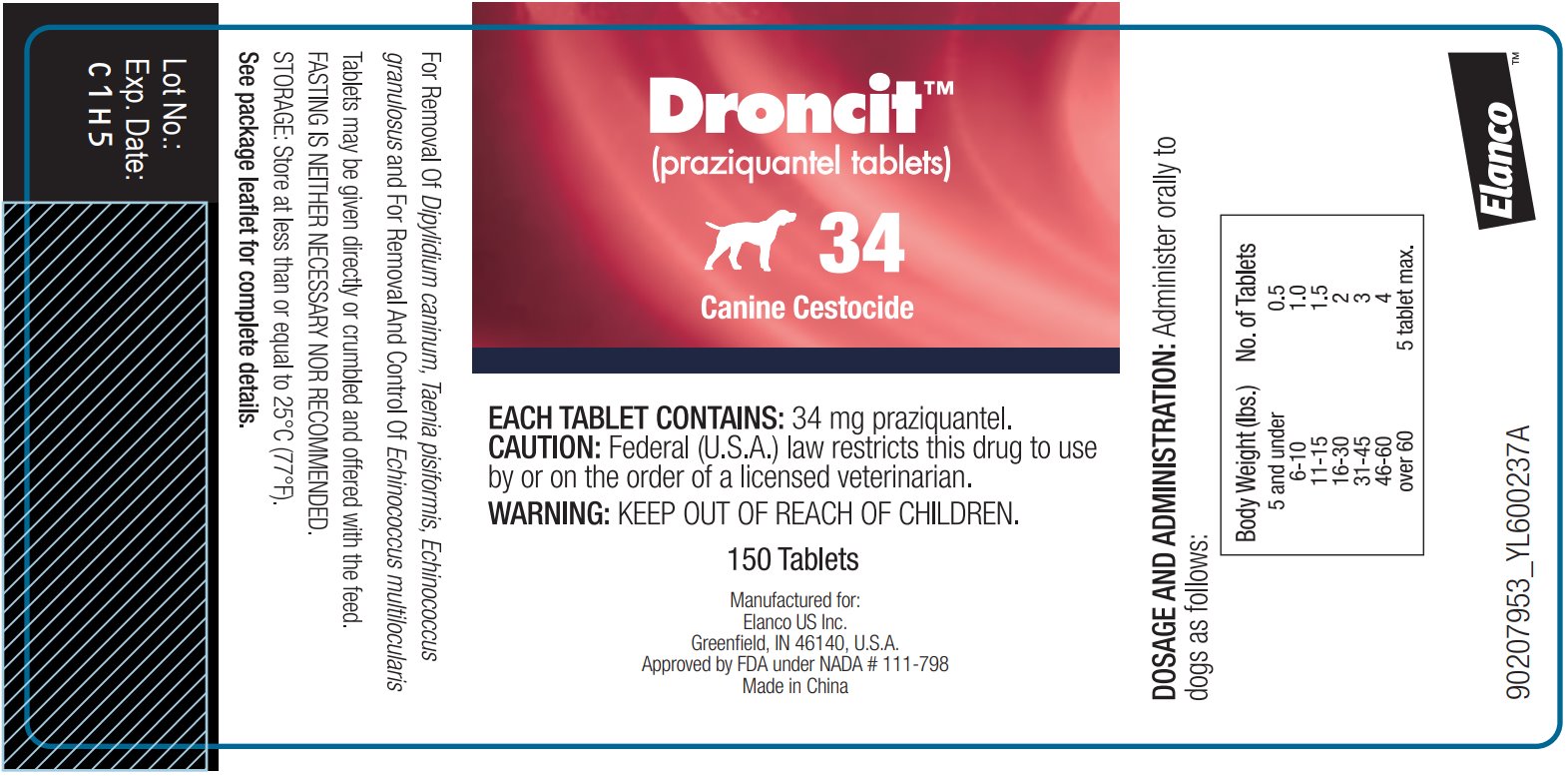DRONCIT CANINE CESTOCIDE- praziquantel tablet
Droncit by
Drug Labeling and Warnings
Droncit by is a Animal medication manufactured, distributed, or labeled by Elanco US Inc., Merck KG auf Aktien. Drug facts, warnings, and ingredients follow.
Drug Details [pdf]
- SPL UNCLASSIFIED SECTION
- DESCRIPTION:
- INDICATIONS:
- CONTRAINDICATIONS:
-
ACTION:
Droncit (praziquantel tablets) is absorbed, metabolized in the liver and excreted in the bile. Upon entering the digestive tract from the bile, cestocidal activity is exhibited.1 Following exposure to praziquantel, the tapeworm loses its ability to resist digestion by the mammalian host. Because of this, whole tapeworms, including the scolex, are very rarely passed after administration of praziquantel. In many instances only disintegrated and partially digested pieces of tapeworms will be seen in the stool. The majority of tapeworms are digested and are not found in the feces.
-
USE DIRECTIONS:
Droncit (praziquantel tablets) 34 Canine Cestocide may be administered directly per os or crumbled and mixed with the feed. The recommended dosage of praziquantel varies according to body weight. Smaller animals require a relatively larger dosage because of their higher metabolic rate. The optimum dose for each individual animal will be achieved by utilizing the following dosage schedule:
Dogs and Puppies* * Not intended for use in puppies less than 4 weeks of age. 5 lbs. and under
½ tablet
6-10 lbs.
1 tablet
11-15 lbs.
1 ½ tablets
16-30 lbs.
2 tablets
31-45 lbs.
3 tablets
46-60 lbs.
4 tablets
Over 60 lbs.
5 tablets max
- FASTING:
-
RETREATMENT:
For those animals living where reinfections are likely to occur, clients should be instructed in the steps to optimize prevention, otherwise, retreatment may be necessary. This is true in cases of Dipylidium caninum where reinfection is almost certain to occur if fleas are not removed from the animal and its environment. In addition, for control of Echinococcus multilocularis, a program of regular treatment every 21 to 26 days may be indicated (see E. multilocularis section below).
-
ECHINOCOCCUS MULTILOCULARIS:
Echinococcus multilocularis is a tapeworm species ordinarily considered to be found in wild canids, including foxes, coyotes and wolves. The parasite has also been identified in domestic dogs and cats and potentially is a serious public health concern by involving humans as accidental intermediate hosts.
The life cycle of the parasite is based on a predator-prey relationship, as depicted.
The adult tapeworm is small (1-4 mm) and resides in the intestinal tract of the definitive host (wild or domestic canids). Eggs from the adult tapeworm are shed in the feces of the infected canid. Rodents such as mice and voles serve as the intermediate host for E. multilocularis. Eggs ingested by rodents develop in the liver, lungs and other organs to form multilocular cysts. The life cycle is completed after a canid consumes a rodent infected with cysts. After ingestion of an infected rodent, larvae contained within the cyst develop into adult tapeworms in the intestinal tract of the canid. Eggs may begin to be passed in the feces of the canid approximately 28 days later.
This parasite poses a serious public health problem because of the possibility for human involvement in the life cycle. If eggs shed by an infected canid are accidentally ingested, a highly pathogenic condition (Alveolar Hydatid Disease) results from development of the cyst stage in humans.
The original geographic distribution of E. multilocularis was primarily confined to northern areas of North America. Current evidence indicates migration of the parasite well into the continental United States.2,3
Domestic dogs living in E. multilocularis endemic areas that roam freely with the opportunity to catch wild rodents are at risk for infection. Pet owners should be advised on how to minimize this risk. Proper restraint of roaming dogs should be encouraged, along with regular treatment with Droncit (praziquantel tablets) following the established dosage schedule (above) and the precautions indicated below.
Additional information on the life cycle and epidemiology of this parasite is available in veterinary parasitology texts.4,5
-
DIAGNOSIS:
Diagnosis of E. multilocularis in canids is difficult. The adult tapeworm produces no clinical signs of infection. Tapeworm segments (proglottids) are usually not observed in the feces. E. multilocularis eggs, observed using microscopic fecal examination procedures, are similar in appearance to the common taeniid species of canids such as Taenia pisiformis.
Assistance in the diagnosis of E. multilocularis may be available from a state veterinary diagnostic laboratory. Additional information regarding areas where E. multilocularis is suspected or has been confirmed may be obtained from area veterinary schools or the Centers for Disease Control in Atlanta, GA.
-
TREATMENT:
Dogs infected with E. multilocularis should be treated to prevent exposure of humans to infective eggs and to reduce perpetuation of the parasite’s life cycle.
The dosage of Droncit (praziquantel tablets) for removal of E. multilocularis is the same as that indicated for the removal of the other tapeworm species listed on the label. Laboratory efficacy studies have demonstrated the recommended dosage is 100% efficacious for removal of this tapeworm.
Under condition of continual exposure to wild rodents, retreatment of the dog at 21-26 day intervals is recommended to prevent the shedding of infectious eggs.
-
PRECAUTIONS:
Strict hygienic precautions should be taken when handling dogs or feces suspected of harboring E. multilocularis. Infected dogs treated for the first time with Droncit (praziquantel tablets) and dogs treated at intervals greater than 28 days may shed eggs in the feces after treatment. The animal should be held in the clinic during this interval and all feces should be incinerated or autoclaved. If these procedures are not possible, the eggs can be destroyed by soaking the feces in a sodium hypochlorite (bleach) solution of 3.75% or greater.6 All areas where the animal was maintained or in contact with should be thoroughly cleaned with sodium hypochlorite and allowed to dry completely before reuse.
-
ANIMAL SAFETY:
The safety index has been derived from controlled safety evaluations, clinical trials and prior approved use in foreign countries. Dosages of 5 times the labeled rate at 14 day intervals to dogs as young as 4 weeks did not produce clinical signs of toxicity. No significant clinical chemistry, hematological, cholinesterase, or histopathological changes occurred. Symptoms of gross overdosage include vomition, salivation, diarrhea and depression.
- PREGNANCY:
-
ADVERSE REACTIONS:
Seven instances (3.2%) of either vomiting, anorexia, lethargy or diarrhea were reported during the field trials in which 218 dogs were administered Droncit (praziquantel tablets) 34 canine cestocide. The investigators rated these as non-significant.
For additional information about reporting adverse drug experiences for animal drugs, contact FDA at 1-888-FDA-VETS or http://www.fda.gov/reportanimalae.
- WARNING:
- STORAGE:
- HOW SUPPLIED:
-
REFERENCES:
- 1. Andrews, P. Pharmacokinetic Studies with Droncit in Animals Using a Biological Assay. Veterinary Medical Review 2/76: 154-165.
- 2. Hildreth, M.B., Johnson, M.D. and Kozacos, K.R. 1991. A Zoonosis of Increasing Concern in the United States. Compendium for Cont Ed 13(5): 727-740.
- 3. Lieby, P.D., Carney, W.P., and Woods, C.E. 1970. Studies on Sylvatic Echinococcosis. Ill. Host Occurrence and Geographic Distribution of Echinococcus multilocularis in the North Central United States. J Parasit 56(6): 1141-1150.
- 4. Georgi, J.R. and Georgi M.E. 1990. Parasitology for Veterinarians.W.B. Saunders Co. 118-138.
- 5. Soulsby, E.J.L. 1982. Helminths, Arthropods and Protozoa of Domesticated Animals. 7th Edition. Lea & Febigir 118-138.
- 6. Craig, P.S. and McPharson, C.N.L. 1988. Sodium Hypochlorite as an Ovicide for Echinococcus. Ann Trop Med and Parasit 82(2): 211-213.
Manufactured for:
Elanco US Inc.
Greenfield, IN 46140, U.S.A.
Made in ChinaDroncit, Elanco and the diagonal bar logo are trademarks of Elanco or its affiliates.
© 2022 Elanco or its affiliates
Approved by FDA under NADA # 111-79890207980_PA600237X
Revised: March 2022
Elanco™
-
Principal Display Panel
DroncitTM
(praziquantel tablets)
34
Canine Cestocide
EACH TABLET CONTAINS: 34 mg praziquantel.
CAUTION: Federal (U.S.A.) law restricts this drug to use by
or on the order of a licensed veterinarian.WARNING: KEEP OUT OF REACH OF CHILDREN.
50 Tablets
Manufactured for:
Elanco US Inc. Greenfield, IN 46140, U.S.A.
Approved by FDA under NADA # 111-798
Made in ChinaDroncitTM
(praziquantel tablets)
34
Canine Cestocide
EACH TABLET CONTAINS: 34 mg praziquantel.
CAUTION: Federal (U.S.A.) law restricts this drug to use
by or on the order of a licensed veterinarian.WARNING: KEEP OUT OF REACH OF CHILDREN.
150 Tablets
Manufactured for:
Elanco US Inc.
Greenfield, IN 46140, U.S.A.
Approved by FDA under NADA # 111-798
Made in China -
INGREDIENTS AND APPEARANCE
DRONCIT CANINE CESTOCIDE
praziquantel tabletProduct Information Product Type PRESCRIPTION ANIMAL DRUG Item Code (Source) NDC: 58198-0033 Route of Administration ORAL Active Ingredient/Active Moiety Ingredient Name Basis of Strength Strength PRAZIQUANTEL (UNII: 6490C9U457) (PRAZIQUANTEL - UNII:6490C9U457) PRAZIQUANTEL 34 mg Product Characteristics Color white (white to off white) Score 2 pieces Shape ROUND (ROUND) Size 13mm Flavor Imprint Code Droncit;34 Contains Packaging # Item Code Package Description Marketing Start Date Marketing End Date 1 NDC: 58198-0033-1 50 in 1 BOTTLE 2 NDC: 58198-0033-2 150 in 1 BOTTLE Marketing Information Marketing Category Application Number or Monograph Citation Marketing Start Date Marketing End Date NADA NADA111798 12/11/1981 Labeler - Elanco US Inc. (966985624)
Trademark Results [Droncit]
Mark Image Registration | Serial | Company Trademark Application Date |
|---|---|
 DRONCIT 73115952 1074425 Live/Registered |
BAYER AKTIENGESELLSCHAFT 1977-02-15 |
© 2025 FDA.report
This site is not affiliated with or endorsed by the FDA.


